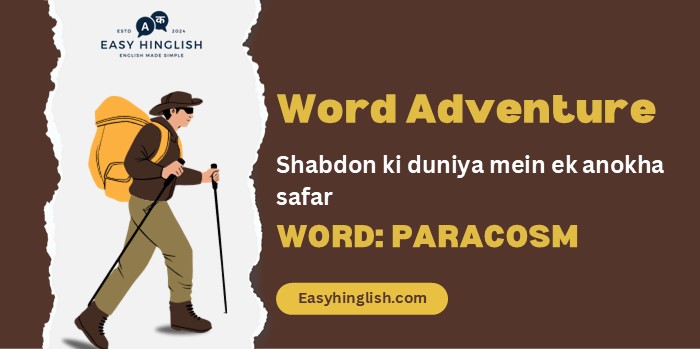Word Adventure: Paracosm
The Headline
“Paracosm: Woh Elaborate Imaginary Worlds Jo Real Genius Shape Karte Hain”
The Scoop
Human imagination ke landscape mein, kuch creations apni extraordinary depth aur complexity ke liye stand out karte hain. ‘Paracosm’ in elaborate imaginary worlds ko ek naam deta hai – woh detailed fictional universes jo pehle childhood play mein create hote hain aur sometimes creative adults ke dwara cultural phenomena mein develop kiye jaate hain. Aaj, hum is fascinating concept explore karenge jo developmental psychology aur creative expression bridge karta hai, revealing karte hue ki kaise yeh private fantasy realms exceptional creativity aur innovation se connected ho sakte hain.
Let’s Break It Down
The Plot Thickens
‘Paracosm’ hamare lexicon mein ek relatively new term hai, 1970s mein developmental psychologist Robert Silvey ne coin kiya, though jo phenomenon yeh describe karta hai woh human imagination jitna old hai. Word Greek “para” (beside, beyond) ko “kosmos” (world, universe) ke saath combine karta hai, effectively capture karte hue ki kaise yeh imaginary realms hamare own reality ke parallel exist karte hain.
Jo paracosm ko ordinary pretend play ya daydreaming se distinguish karta hai woh hai iska exceptional detail aur consistency. True paracosms ki apni geography, history, language, social structures, aur even natural laws hoti hain. Woh often years over evolve karte hain, unke creators complexity ki layers add karte hue aur internal contradictions resolve karte hue jaise woh mature hote hain.
Research ne paracosm creation aur creative development ke beech fascinating connections suggest kiye hain. Kai renowned artists, writers, aur scientists – Brontë siblings se jinke childhood worlds Angria aur Gondal the, C.S. Lewis aur J.R.R. Tolkien tak, jinke childhood paracosms eventually Narnia aur Middle-earth mein evolve hue – prolific paracosm creators rahe hain. Isse kuch psychologists yeh suggest karne lage hain ki paracosms ki detailed world-building creative thinking, divergent cognition, aur narrative skills develop karne mein help kar sakti hai jo later extraordinary innovation fuel karte hain.
Word in the Wild
The Twist
Yahan ek thought-provoking aspect hai ‘paracosm’ ka: While hum typically elaborate imaginary worlds ko childhood ya fiction ke saath associate karte hain, similar mental constructs scientific aur philosophical innovation mein appear karte hain. Einstein ne describe kiya tha ki usne imagine kiya tha apne aap ko light beam ke alongside ride karte hue before relativity theory develop karna. Philosophy mein thought experiments—jaise John Rawls ka “veil of ignorance” ya Thomas Nagel ki bat consciousness mein inquiry—complex ideas explore karne ke liye specific rules ke saath hypothetical scenarios create karte hain. Yeh mere analogies nahi hain balki structured imaginary spaces hain ideas test karne ke liye. Yeh suggest karta hai ki paracosm-like thinking human cognition ke liye fundamental ho sakti hai across domains. Shayad detailed mental worlds create aur manipulate karne ki ability—whether elves aur dragons se filled ho ya quantum particles aur ethical principles se—ek core cognitive tool represent karti hai jo human innovation ke kai forms underlie karti hai. Woh child jo carefully apni imaginary kingdom map kar rahi hai shayad same mental muscles develop kar rahi hai jo later scientists climate systems model karne ya philosophers ethical frameworks construct karne mein use karte hain!
Make It Stick
Paracosm: Sirf daydreaming nahi—aapke mind ki real estate mein entire universe construct karna!
Your Turn
Sochiye ki kya aapne apni childhood mein koi paracosm create kiya tha—koi detailed imaginary world jismein aap repeatedly return karte the aur time over elaborate karte the. Uski kya features thi? Kya aapne iske liye languages, maps, ya histories create kiye the? Ya phir aapne others ke create kiye gaye fascinating fictional worlds encounter kiye hain jo particularly impress kiye hain aapko unki depth aur consistency se? Imaginary world-building ke saath apne experiences comments mein share kijiye. Chaliye explore karte hain ki mind ke yeh parallel universes kaise hamare creative lives shape kiye hain!
Down the Rabbit Hole
- Curious about famous paracosms? Research kijiye Brontë siblings ke childhood worlds Angria aur Gondal, ya C.S. Lewis aur uske brother ka “Animal-Land” aur “India” creation.
- Interested in imaginary worlds ke behind psychology mein? Look into kijiye studies on paracosm creation aur creative achievement ke beech connection, ya explore kijiye gifted children mein “worldplay” par research.
- Constructed languages explore karna chahte hain? Dive kijiye “conlangs” ki field mein jaise Tolkien ki Elvish languages, Esperanto, ya Dothraki, aur discover kijiye artificial languages create karne ke behind linguistic principles.
The Last Word
Jaise hi hum ‘paracosm’ ki exploration conclude karte hain, main hope karta hun ki aapko in elaborate imaginary worlds aur creative development ke saath unke potential connection ke liye appreciation mili hai. Childhood realms se jo hum solitary play mein create karte hain lekar shared universes tak jo cultural phenomena ban jaate hain, paracosms humein human mind ki extraordinary capacity remind karte hain entire worlds build, populate, aur sustain karne ki beyond reality. Whether aap khud world-builder hain ya simply others ke creations ke visitor, paracosms understand karna insight offer karta hai ki kaise imagination structure karti hai khud ko aur kaise fictional worlds real innovation impact kar sakte hain. Next time jab aap richly detailed fictional universe mein lose karenge yourself ko—ya phir shayad apna own create karna begin karenge—remember kijiye ki aap ek aisi cognitive tradition mein participate kar rahe hain jo fundamentally human creativity se linked ho sakti hai iske most profound par. Until our next word adventure, yeh hai Prashant from Wordpandit, encouraging you to honor the worlds within jaise aap world without navigate karte hain!








